Drought Monitoring and Prediction in Agriculture: Employing Earth Observation Data, Climate Scenarios and Data Driven Methods; a Case Study: Mango Orchard in Tamale, Ghana
Abstract
:1. Introduction
2. Materials and Methods
2.1. Study Area and Precipitation Data
2.2. Extracting Precipitation Data for Time Interval of 2023–2050 Using CMIP6 Data
2.3. Landsat 8 and 9 Satellite Image Acquisition and Data Preprocessing
2.4. NDVI and TVDI Calculation Using Landsat Satellite Imagery
2.5. Ortho Image Creation from UAV Imagery
2.6. Standard Precipitation Index (SPI)
2.7. Prediction of Agricultural Drought by a Hybrid Wavelet-ANFIS/Fuzzy C-Means (FCM) Clustering Model
2.7.1. Multiresolution Analysis of Input Data Using the Discrete Wavelet Transform
2.7.2. Fuzzy C-Means (FCM) Clustering
2.7.3. Hybrid Wavelet-ANFIS/FCM Model
3. Results and Discussions
3.1. Meteorological and Agricultural Drought Index
3.2. Climate Change Scenarios
3.3. Wavelet ANFIS Model Results
4. Conclusions
Author Contributions
Funding
Data Availability Statement
Conflicts of Interest
References
- IPCC. Climate Change 2022: Impacts, Adaptation, and Vulnerability. Contribution of Working Group II to the Sixth Assessment Report of the Intergovernmental Panel on Climate Change; Pörtner, H.-O., Roberts, D.C., Tignor, M., Poloczanska, E.S., Mintenbeck, K., Alegría, A., Craig, M., Langsdorf, S., Löschke, S., Möller, V., et al., Eds.; Cambridge University Press: Cambridge, UK; New York, NY, USA, 2022; 3056p. [Google Scholar] [CrossRef]
- Zare, M.; Schumann, G.J.-P.; Teferle, F.N.; Mansorian, R. Generating Flood Hazard Maps Based on an Innovative Spatial Interpolation Methodology for Precipitation. Atmosphere 2021, 12, 1336. [Google Scholar] [CrossRef]
- Pascoe, C.; Lawrence, B.N.; Guilyardi, E.; Juckes, M.; Taylor, K.E. Documenting Numerical Experiments in Support of the Coupled Model Intercomparison Project Phase 6 (CMIP6). Geosci. Model Dev. 2020, 13, 2149–2167. [Google Scholar] [CrossRef]
- Riahi, K.; van Vuuren, D.P.; Kriegler, E.; Edmonds, J.; O’Neill, B.C.; Fujimori, S.; Bauer, N.; Calvin, K.; Dellink, R.; Fricko, O.; et al. The Shared Socioeconomic Pathways and Their Energy, Land Use, and Greenhouse Gas Emissions Implications: An Overview. Glob. Environ. Change 2017, 42, 153–168. [Google Scholar] [CrossRef]
- Ding, Y.; Gong, X.; Xing, Z.; Cai, H.; Zhou, Z.; Zhang, D.; Sun, P.; Shi, H. Attribution of Meteorological, Hydrological and Agricultural Drought Propagation in Different Climatic Regions of China. Agric. Water Manag. 2021, 255, 106996. [Google Scholar] [CrossRef]
- Van Loon, A.F.; Laaha, G. Hydrological Drought Severity Explained by Climate and Catchment Characteristics. J. Hydrol. 2015, 526, 3–14. [Google Scholar] [CrossRef]
- Paxian, A.; Ziese, M.; Kreienkamp, F.; Pankatz, K.; Brand, S.; Pasternack, A.; Früh, B. User-oriented global predictions of the GPCC drought index for the next decade. Meteorol. Z. 2019, 28, 3–21. [Google Scholar] [CrossRef]
- Wilhite, D.A.; Sivakumar, M.V.K.; Pulwarty, R. Managing Drought Risk in a Changing Climate: The Role of National Drought Policy. Weather Clim. Extrem. 2014, 3, 4–13. [Google Scholar] [CrossRef]
- Zare, M.; Drastig, K.; Zude-Sasse, M. Tree Water Status in Apple Orchards Measured by Means of Land Surface Temperature and Vegetation Index (LST–NDVI) Trapezoidal Space Derived from Landsat 8 Satellite Images. Sustainability 2020, 12, 70. [Google Scholar] [CrossRef]
- Sun, D.; Pinker, R.T. Estimation of Land Surface Temperature from a Geostationary Operational Environmental Satellite (GOES-8). J. Geophys. Res. Atmos. 2003, 108. [Google Scholar] [CrossRef]
- Sheng, J.; Wilson, J.P.; Lee, S. Comparison of Land Surface Temperature (LST) Modeled with a Spatially-Distributed Solar Radiation Model (SRAD) and Remote Sensing Data. Environ. Model. Softw. 2009, 24, 436–443. [Google Scholar] [CrossRef]
- Yang, J.; Wang, Y. Estimating Evapotranspiration Fraction by Modeling Two-Dimensional Space of NDVI/Albedo and Day–Night Land Surface Temperature Difference: A Comparative Study. Adv. Water Resour. 2011, 34, 512–518. [Google Scholar] [CrossRef]
- Zare, M.; Drastig, K.; Zude-Sasse, M. Estimating Tree Water Status in Apple Orchard Using Reflectance in the Thermal Domain of Landsat 8 Satellite. In Proceedings of the 2019 IEEE International Workshop on Metrology for Agriculture and Forestry (MetroAgriFor), Portici, Italy, 24–26 October 2019; pp. 255–259. [Google Scholar] [CrossRef]
- Bedair, H.; Alghariani, M.S.; Omar, E.; Anibaba, Q.A.; Remon, M.; Bornman, C.; Alzain, H.M. Global Warming Status in the African Continent: Sources, Challenges, Policies, and Future Direction. Int. J. Environ. Res. 2023, 17, 45. [Google Scholar] [CrossRef]
- Yi, Q.; Bao, A.; Wang, Q.; Zhao, J. Estimation of Leaf Water Content in Cotton by Means of Hyperspectral Indices. Comput. Electron. Agric. 2013, 90, 144–151. [Google Scholar] [CrossRef]
- Guermazi, E.; Bouaziz, M.; Zairi, M. Water Irrigation Management Using Remote Sensing Techniques: A Case Study in Central Tunisia. Environ. Earth Sci. 2016, 75, 202. [Google Scholar] [CrossRef]
- Ozelkan, E.; Chen, G.; Ustundag, B.B. Multiscale Object-Based Drought Monitoring and Comparison in Rainfed and Irrigated Agriculture from Landsat 8 OLI Imagery. Int. J. Appl. Earth Obs. Geoinf. 2016, 44, 159–170. [Google Scholar] [CrossRef]
- Veysi, S.; Naseri, A.A.; Hamzeh, S.; Bartholomeus, H. A Satellite Based Crop Water Stress Index for Irrigation Scheduling in Sugarcane Fields. Agric. Water Manag. 2017, 189, 70–86. [Google Scholar] [CrossRef]
- Nugraha, A.S.A.; Gunawan, T.; Kamal, M. Modification of Temperature Vegetation Dryness Index (TVDI) Method for Detecting Drought with Multi-Scale Image. IOP Conf. Ser. Earth Environ. Sci. 2022, 1039, 012048. [Google Scholar] [CrossRef]
- Brion, G.M.; Neelakantan, T.R.; Lingireddy, S. A Neural-Network-Based Classification Scheme for Sorting Sources and Ages of Fecal Contamination in Water. Water Res. 2002, 36, 3765–3774. [Google Scholar] [CrossRef] [PubMed]
- Goel, A.; Goel, A.K.; Kumar, A. The Role of Artificial Neural Network and Machine Learning in Utilizing Spatial Information. Spat. Inf. Res. 2023, 31, 275–285. [Google Scholar] [CrossRef]
- Nayak, P.C.; Sudheer, K.P.; Rangan, D.M.; Ramasastri, K.S. A Neuro-Fuzzy Computing Technique for Modeling Hydrological Time Series. J. Hydrol. 2004, 291, 52–66. [Google Scholar] [CrossRef]
- Zare, M.; Koch, M. Hybrid Signal Processing/Machine Learning and PSO Optimization Model for Conjunctive Management of Surface–Groundwater Resources. Neural Comput. Appl. 2021, 33, 8067–8088. [Google Scholar] [CrossRef]
- Jang, J.-S. ANFIS: Adaptive-network-based fuzzy inference system. IEEE Trans. Syst. Man Cybern. 1993, 23, 665–685. [Google Scholar] [CrossRef]
- Jang, J.-S.; Sun, C.-T. Neuro-Fuzzy Modeling and Control. Proc. IEEE 1995, 83, 378–406. [Google Scholar] [CrossRef]
- Zare, M. Application and Analysis of Physical and Data-Driven Stochastic Hydrological Simulation-Optimization Methods for the Optimal Management of Surface-Groundwater Resources Systems; University of Kassel: Kassel, Germany, 2017. [Google Scholar]
- Dikshit, A.; Pradhan, B.; Santosh, M. Artificial Neural Networks in Drought Prediction in the 21st Century—A Scientometric Analysis. Appl. Soft Comput. 2022, 114, 108080. [Google Scholar] [CrossRef]
- Mohammed, S.; Elbeltagi, A.; Bashir, B.; Alsafadi, K.; Alsilibe, F.; Alsalman, A.; Zeraatpisheh, M.; Széles, A.; Harsányi, E. A Comparative Analysis of Data Mining Techniques for Agricultural and Hydrological Drought Prediction in the Eastern Mediterranean. Comput. Electron. Agric. 2022, 197, 106925. [Google Scholar] [CrossRef]
- Prodhan, F.A.; Zhang, J.; Hasan, S.S.; Pangali Sharma, T.P.; Mohana, H.P. A Review of Machine Learning Methods for Drought Hazard Monitoring and Forecasting: Current Research Trends, Challenges, and Future Research Directions. Environ. Model. Softw. 2022, 149, 105327. [Google Scholar] [CrossRef]
- Adnan, R.M.; Dai, H.-L.; Kuriqi, A.; Kisi, O.; Zounemat-Kermani, M. Improving Drought Modeling Based on New Heuristic Machine Learning Methods. Ain Shams Eng. J. 2023, 14, 102168. [Google Scholar] [CrossRef]
- Zare, M.; Koch, M. Groundwater Level Fluctuations Simulation and Prediction by ANFIS- and Hybrid Wavelet-ANFIS/Fuzzy C-Means (FCM) Clustering Models: Application to the Miandarband Plain. J. Hydro-Environ. Res. 2018, 18, 63–76. [Google Scholar] [CrossRef]
- Petrie, R.; Denvil, S.; Ames, S.; Levavasseur, G.; Fiore, S.; Allen, C.; Antonio, F.; Berger, K.; Bretonnière, P.-A.; Cinquini, L.; et al. Coordinating an Operational Data Distribution Network for CMIP6 Data. Geosci. Model Dev. 2021, 14, 629–644. [Google Scholar] [CrossRef]
- Zare, M. Download CMIP6 Data. Available online: https://Github.Com/Hyddata/CMIP6_data (accessed on 21 March 2024).
- Giustarini, L.; Schumann, G.J.-P.; Kettner, A.J.; Smith, A.; Nawrotzki, R. Simulating Changes in Hydrological Extremes—Future Scenarios for Morocco. Water 2023, 15, 2722. [Google Scholar] [CrossRef]
- USGS. Landsat 8 Data Users Handbook; USGS: Sioux Falls, SD, USA, 2016. [Google Scholar]
- USGS. Landsat 9 Data Users Handbook; USGS: Sioux Falls, SD, USA, 2022. [Google Scholar]
- Tucker, C.J. Red and Photographic Infrared Linear Combinations for Monitoring Vegetation. Remote Sens. Environ. 1979, 8, 127–150. [Google Scholar] [CrossRef]
- Mao, K.; Qin, Z.; Shi, J.; Gong, P. A Practical Split-window Algorithm for Retrieving Land-surface Temperature from MODIS Data. Int. J. Remote Sens. 2005, 26, 3181–3204. [Google Scholar] [CrossRef]
- Rozenstein, O.; Qin, Z.; Derimian, Y.; Karnieli, A. Correction: Rozenstein, O.; et al. Derivation of Land Surface Temperature for Landsat-8 TIRS Using a Split Window Algorithm. Sensors 2014, 14, 11277. [Google Scholar] [CrossRef]
- Qin, Z.; Dall’Olmo, G.; Karnieli, A.; Berliner, P. Derivation of Split Window Algorithm and Its Sensitivity Analysis for Retrieving Land Surface Temperature from NOAA-Advanced Very High Resolution Radiometer Data. J. Geophys. Res. Atmos. 2001, 106, 22655–22670. [Google Scholar] [CrossRef]
- Yang, L.; Cao, Y.; Zhu, X.; Zeng, S.; Yang, G.; He, J.; Yang, X. Land Surface Temperature Retrieval for Arid Regions Based on Landsat-8 TIRS Data: A Case Study in Shihezi, Northwest China. J. Arid Land 2014, 6, 704–716. [Google Scholar] [CrossRef]
- Sobrino, J.A.; Jiménez-Muñoz, J.C.; Paolini, L. Land Surface Temperature Retrieval from LANDSAT TM 5. Remote Sens. Environ. 2004, 90, 434–440. [Google Scholar] [CrossRef]
- Nikam, B.R.; Ibragimov, F.; Chouksey, A.; Garg, V.; Aggarwal, S.P. Retrieval of Land Surface Temperature from Landsat 8 TIRS for the Command Area of Mula Irrigation Project. Environ. Earth Sci. 2016, 75, 1169. [Google Scholar] [CrossRef]
- Abuzar, M.; O’Leary, G.; Fitzgerald, G. Measuring Water Stress in a Wheat Crop on a Spatial Scale Using Airborne Thermal and Multispectral Imagery. Field Crops Res. 2009, 112, 55–65. [Google Scholar] [CrossRef]
- Zhang, F.; Zhang, L.-W.; Shi, J.-J.; Huang, J.-F. Soil Moisture Monitoring Based on Land Surface Temperature-Vegetation Index Space Derived from MODIS Data. Pedosphere 2014, 24, 450–460. [Google Scholar] [CrossRef]
- Mckee, T.B.; Doesken, N.J.; Kleist, J.R. The Relationship of Drought Frequency and Duration to Time Scales. In Proceedings of the 8th Conference on Applied Climatology, Anaheim, CA, USA, 17–22 January 1993; pp. 179–184. [Google Scholar]
- Mansorian, R.; Zare, M.; Schumann, G. Study on the Correlation between Meteorological and Agricultural Drought, Based on Remotely Sensed Indices. In Proceedings of the EGU General Assembly Conference Abstracts, Vienna, Austria, 4–8 May 2020; p. 13925. [Google Scholar] [CrossRef]
- Fathian, F. Chapter 3—Introduction of Multiple/Multivariate Linear and Nonlinear Time Series Models in Forecasting Streamflow Process. In Advances in Streamflow Forecasting; Sharma, P., Machiwal, D., Eds.; Elsevier: Amsterdam, The Netherlands, 2021; pp. 87–113. ISBN 978-0-12-820673-7. [Google Scholar]
- Jukić, D.; Denić-Jukić, V.; Kadić, A. Temporal and Spatial Characterization of Sediment Transport through a Karst Aquifer by Means of Time Series Analysis. J. Hydrol. 2022, 609, 127753. [Google Scholar] [CrossRef]
- Mallat, S.G. A Theory for Multiresolution Signal Decomposition: The Wavelet Representation. IEEE Trans. Pattern Anal. Mach. Intell. 1989, 11, 674–693. [Google Scholar] [CrossRef]
- Kim, J.; Chun, C.-Y. Cho Implementation of EKF Combined with Discrete Wavelet Transform-Based MRA for Improved SOC Estimation for a Li-Ion Cell. In Proceedings of the 2013 Twenty-Eighth Annual IEEE Applied Power Electronics Conference and Exposition (APEC), Long Beach, CA, USA, 17–21 March 2013; pp. 2720–2725. [Google Scholar] [CrossRef]
- Holzkämper, A. Adapting Agricultural Production Systems to Climate Change—What’s the Use of Models? Agriculture 2017, 7, 86. [Google Scholar] [CrossRef]

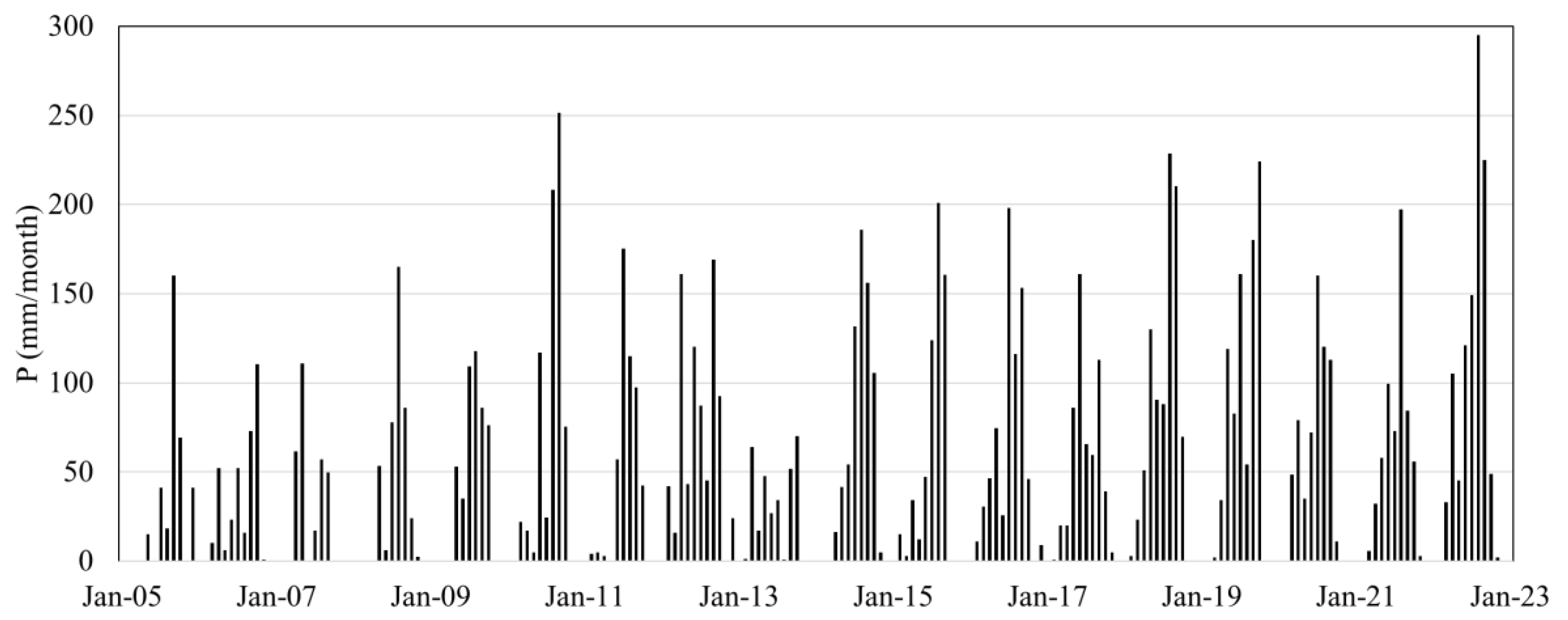
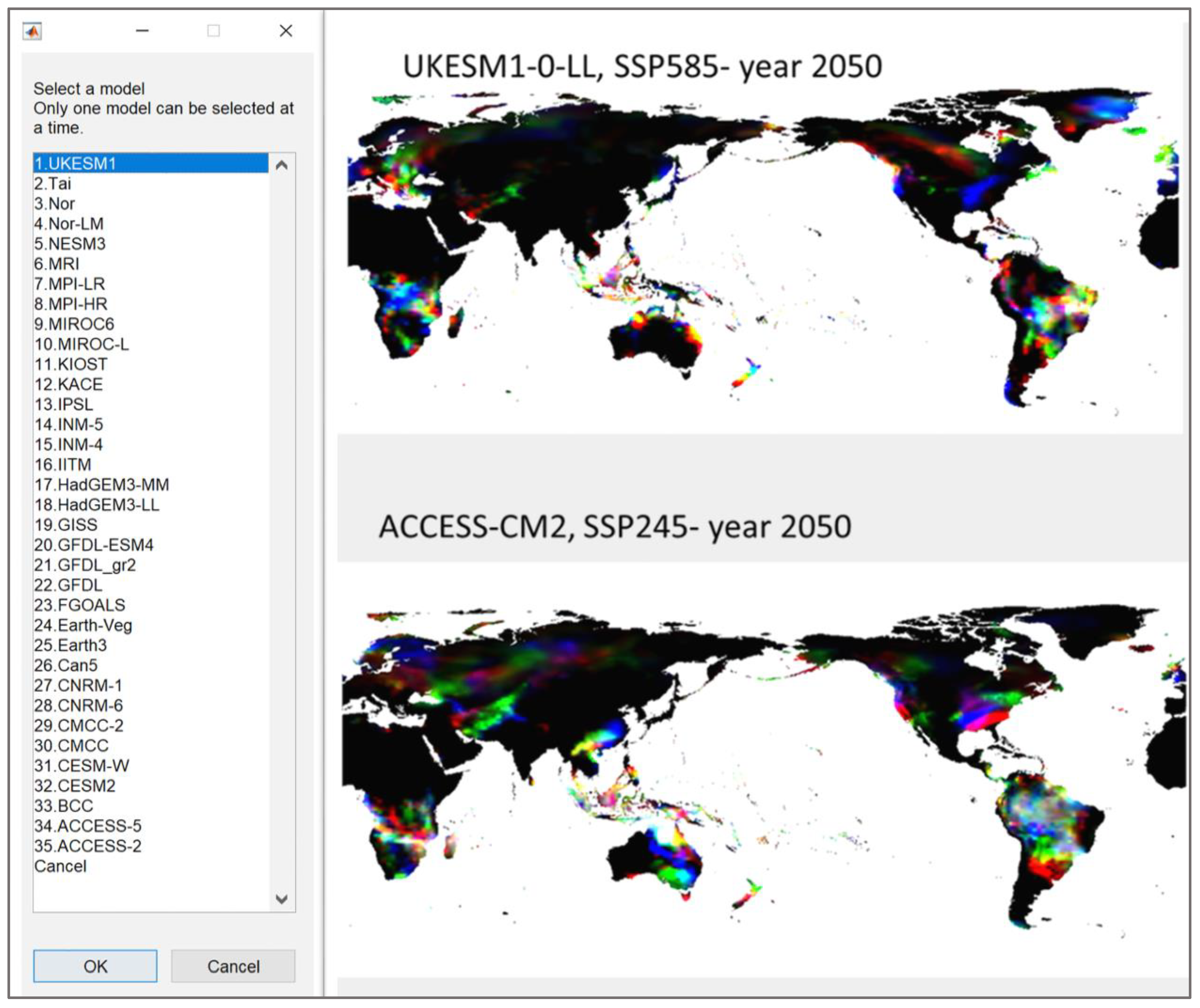

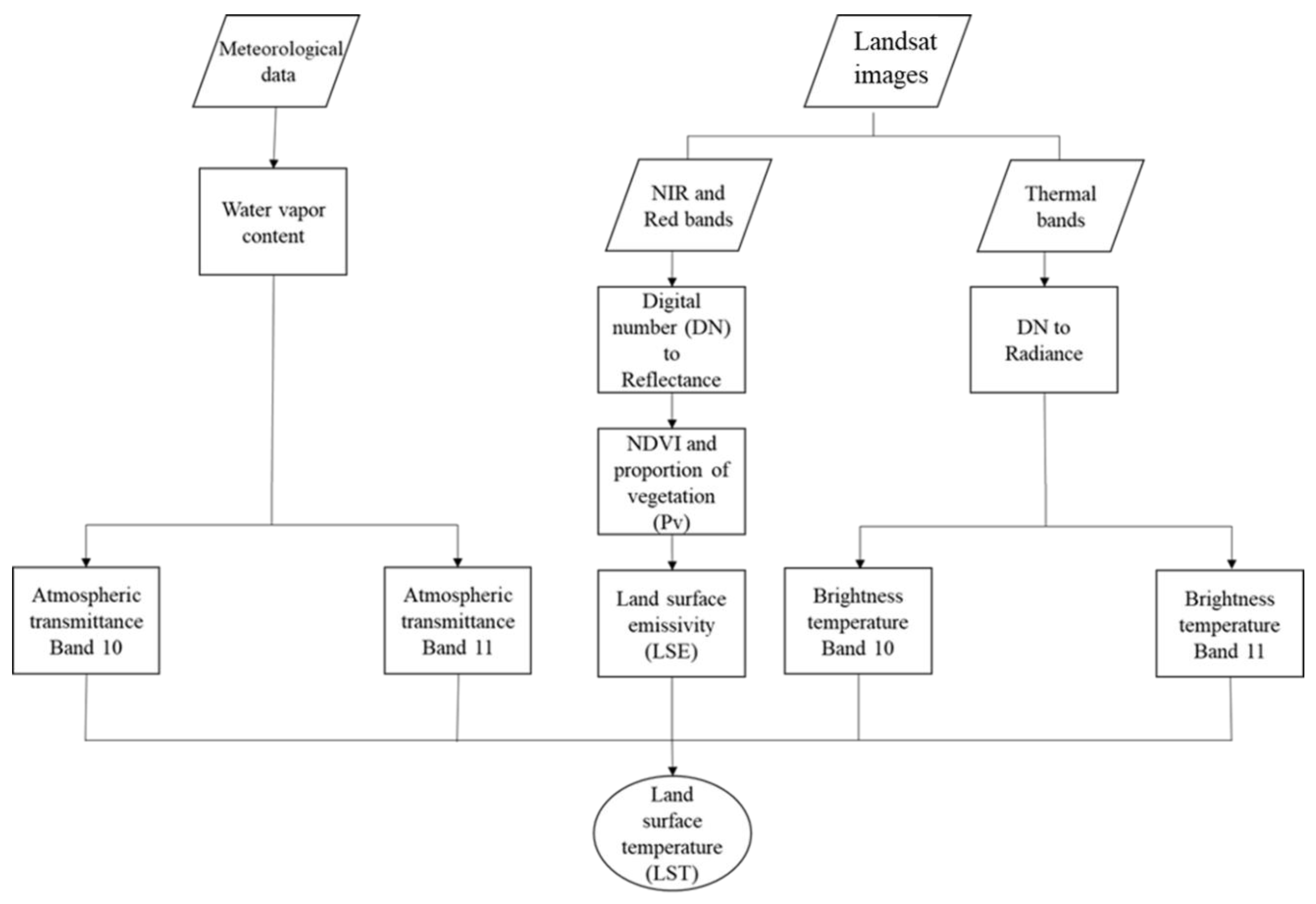
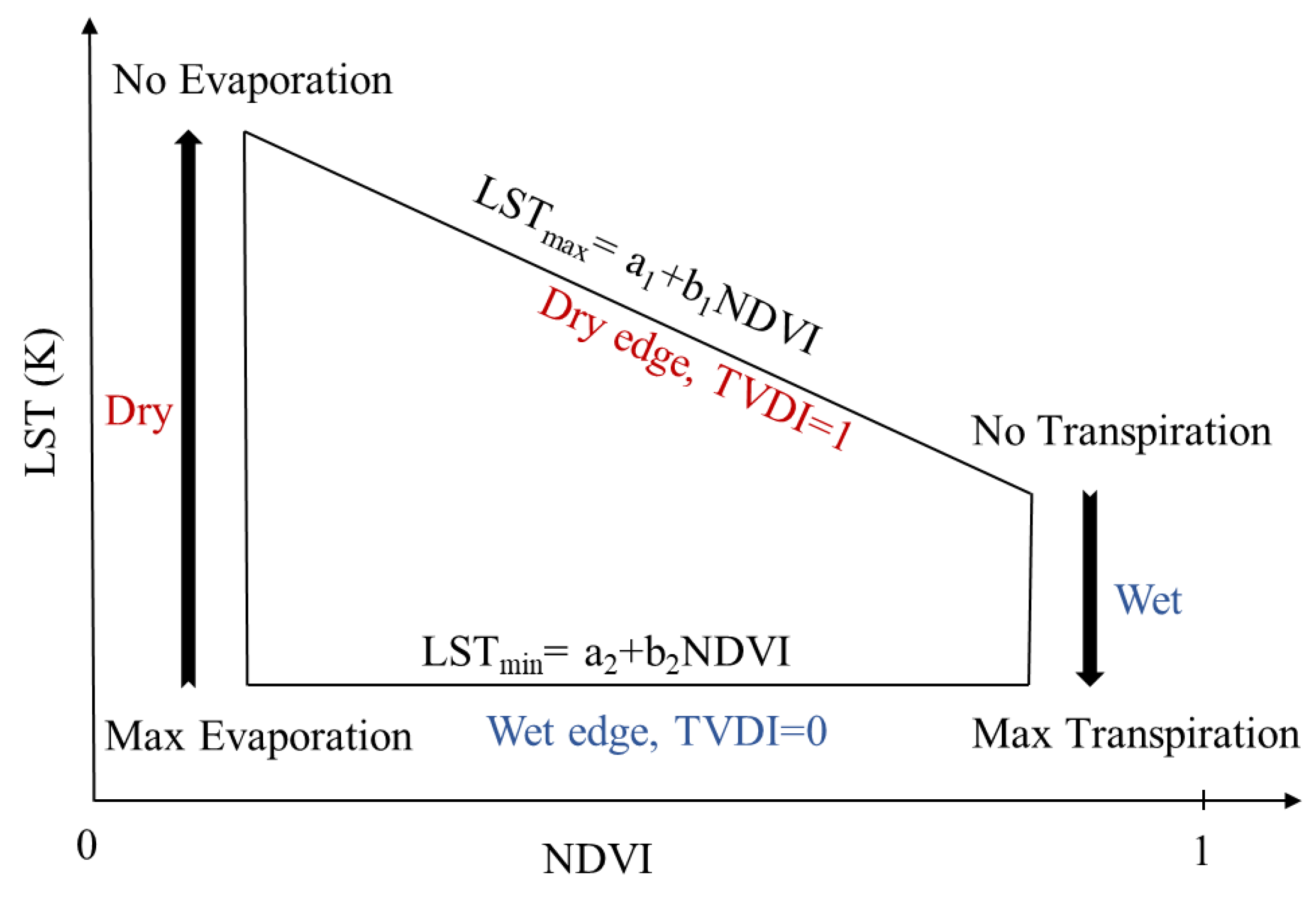
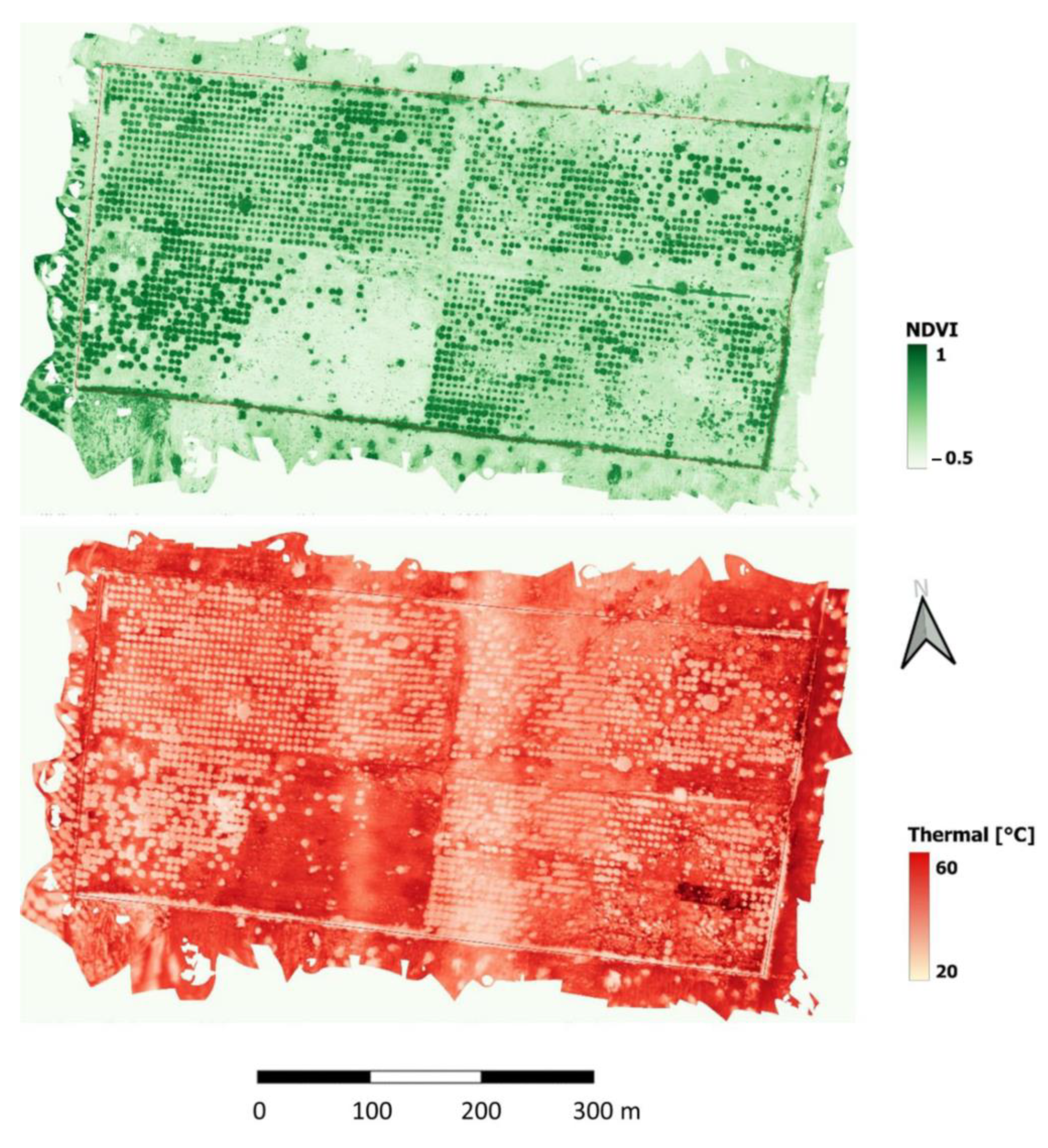



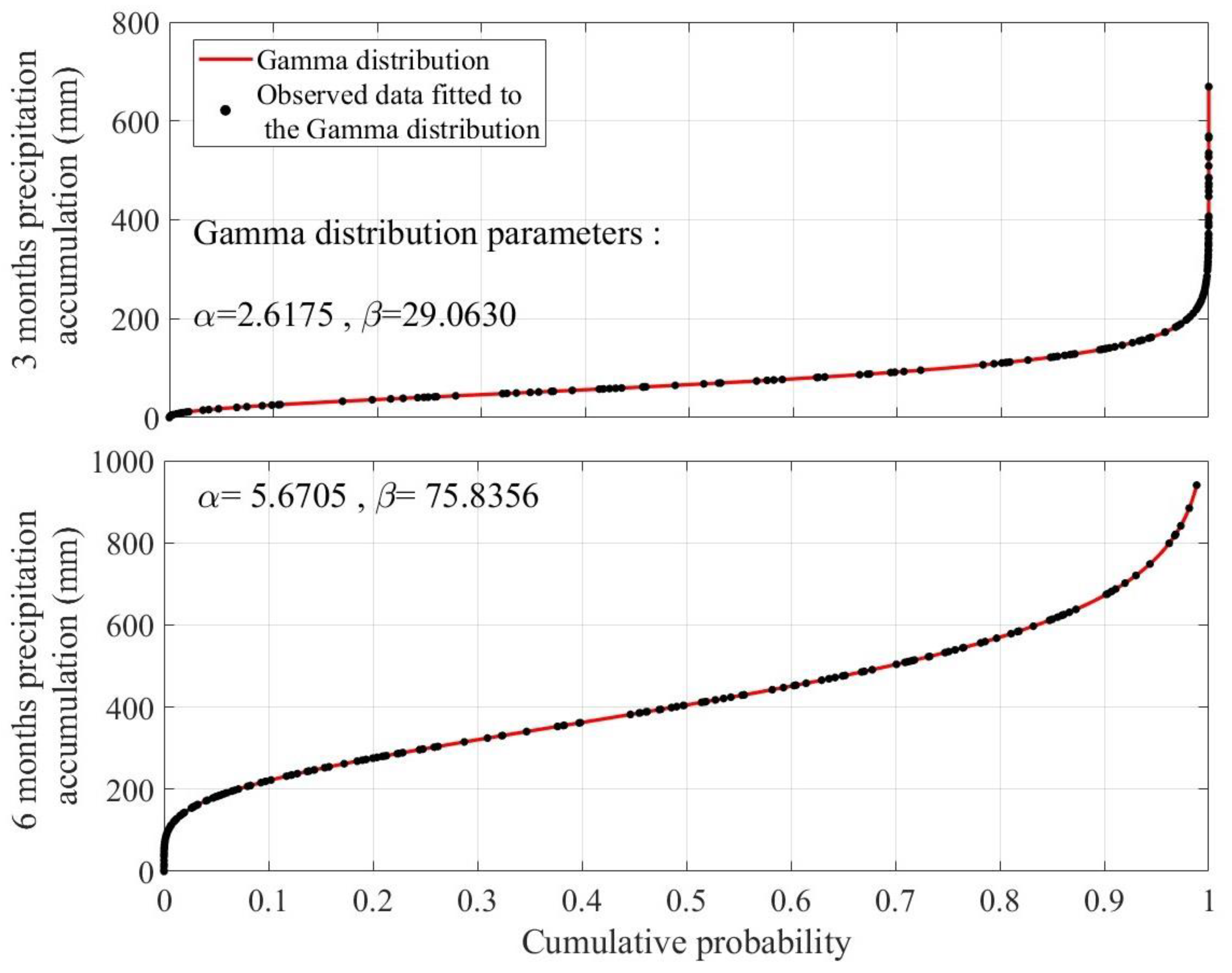
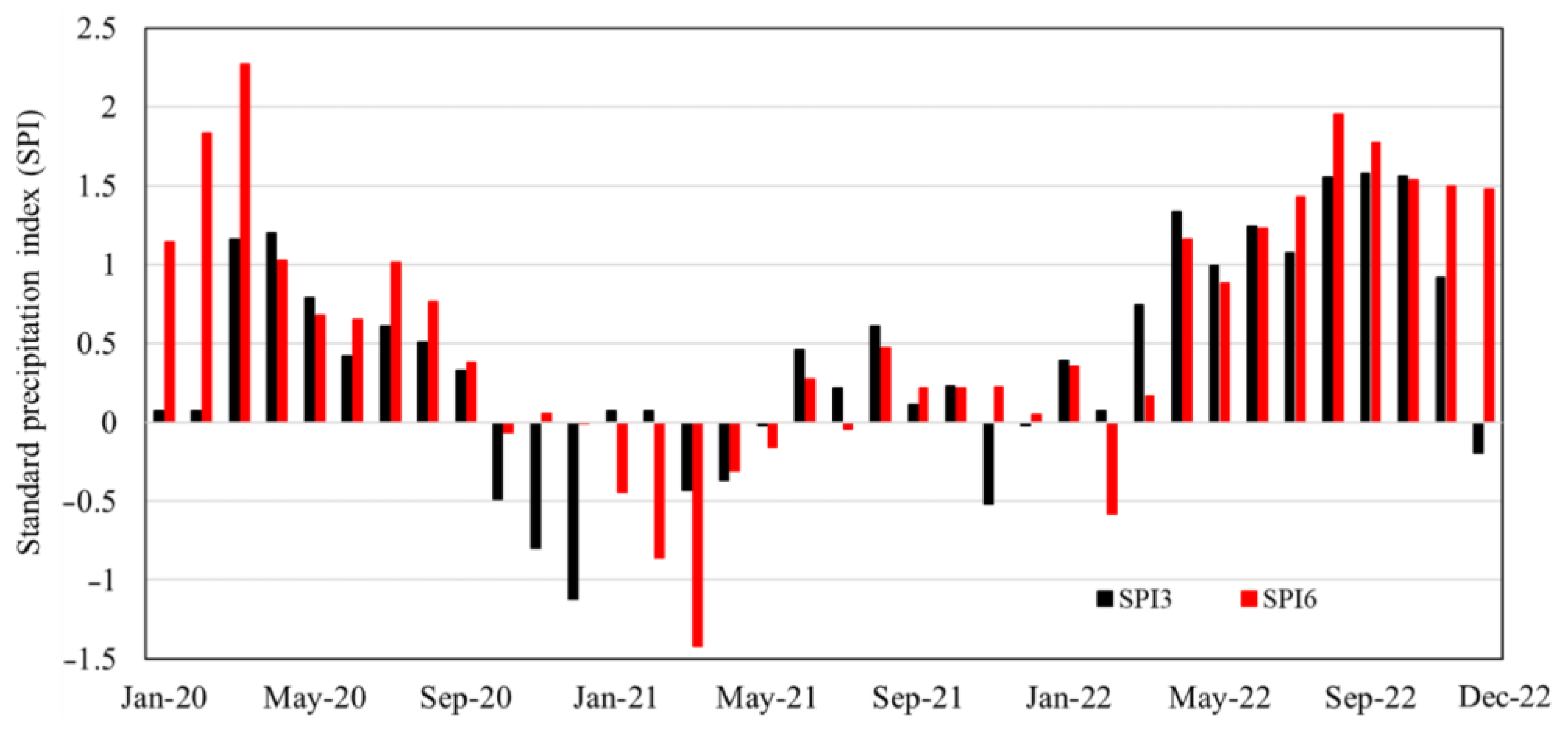
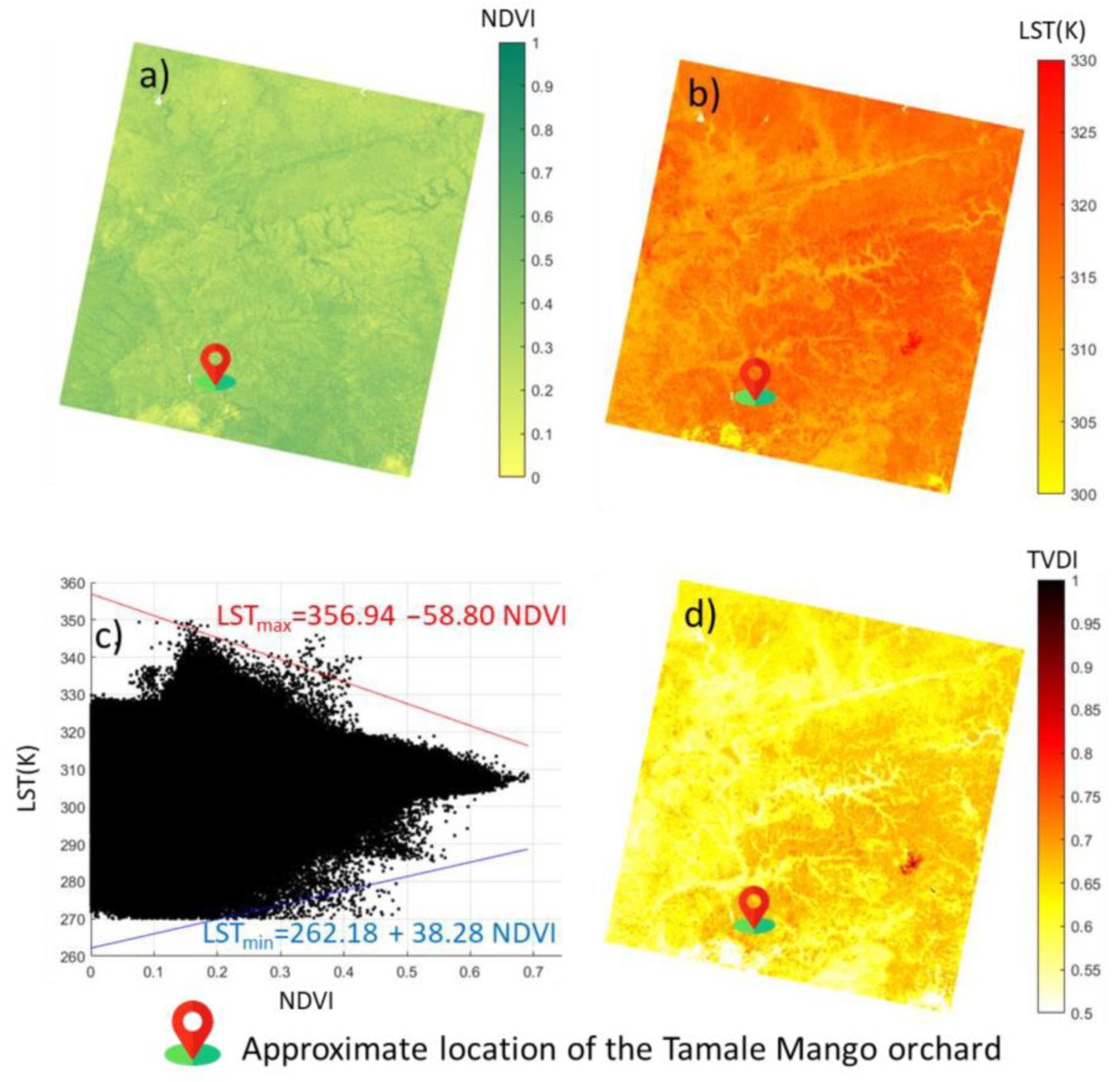
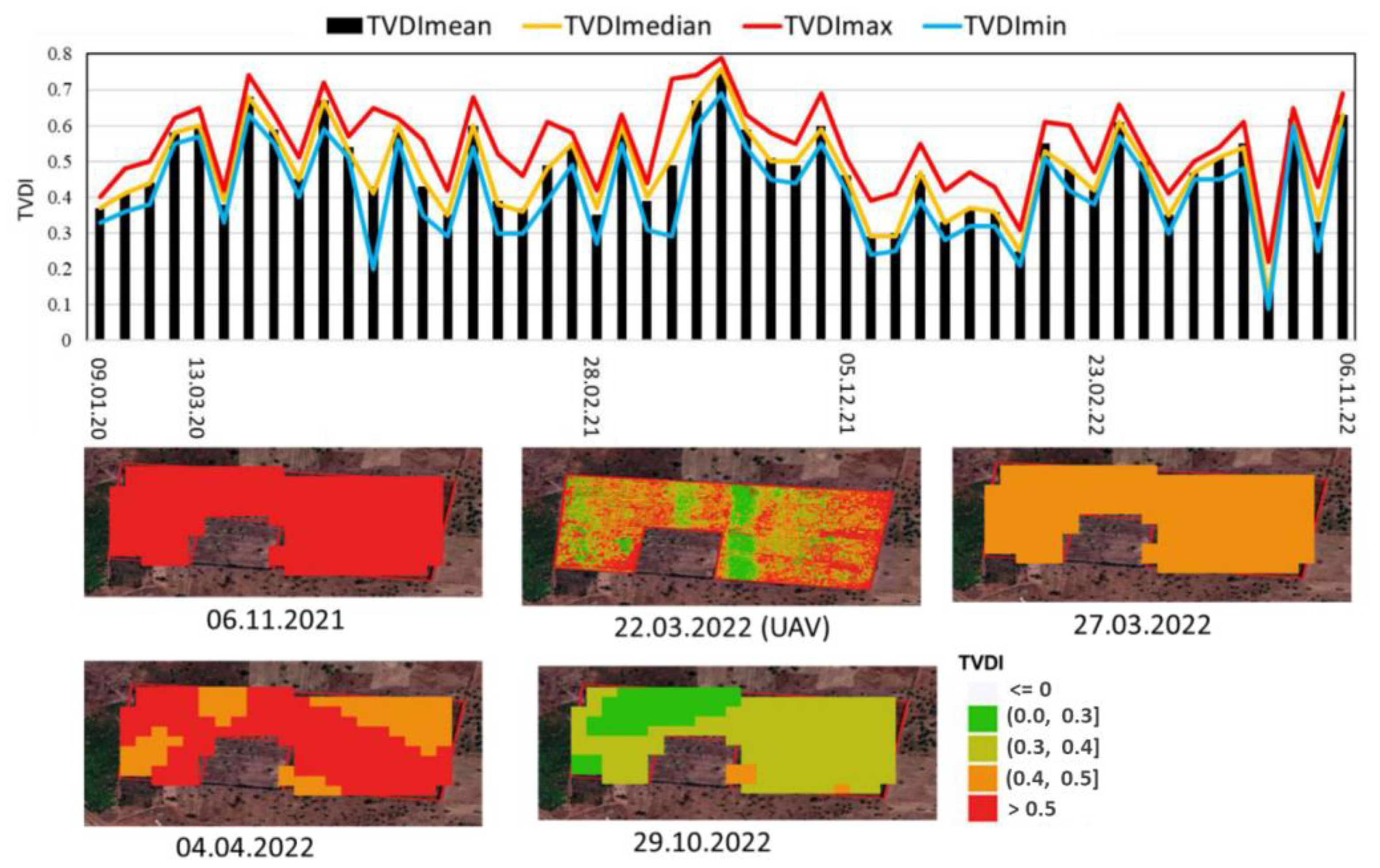
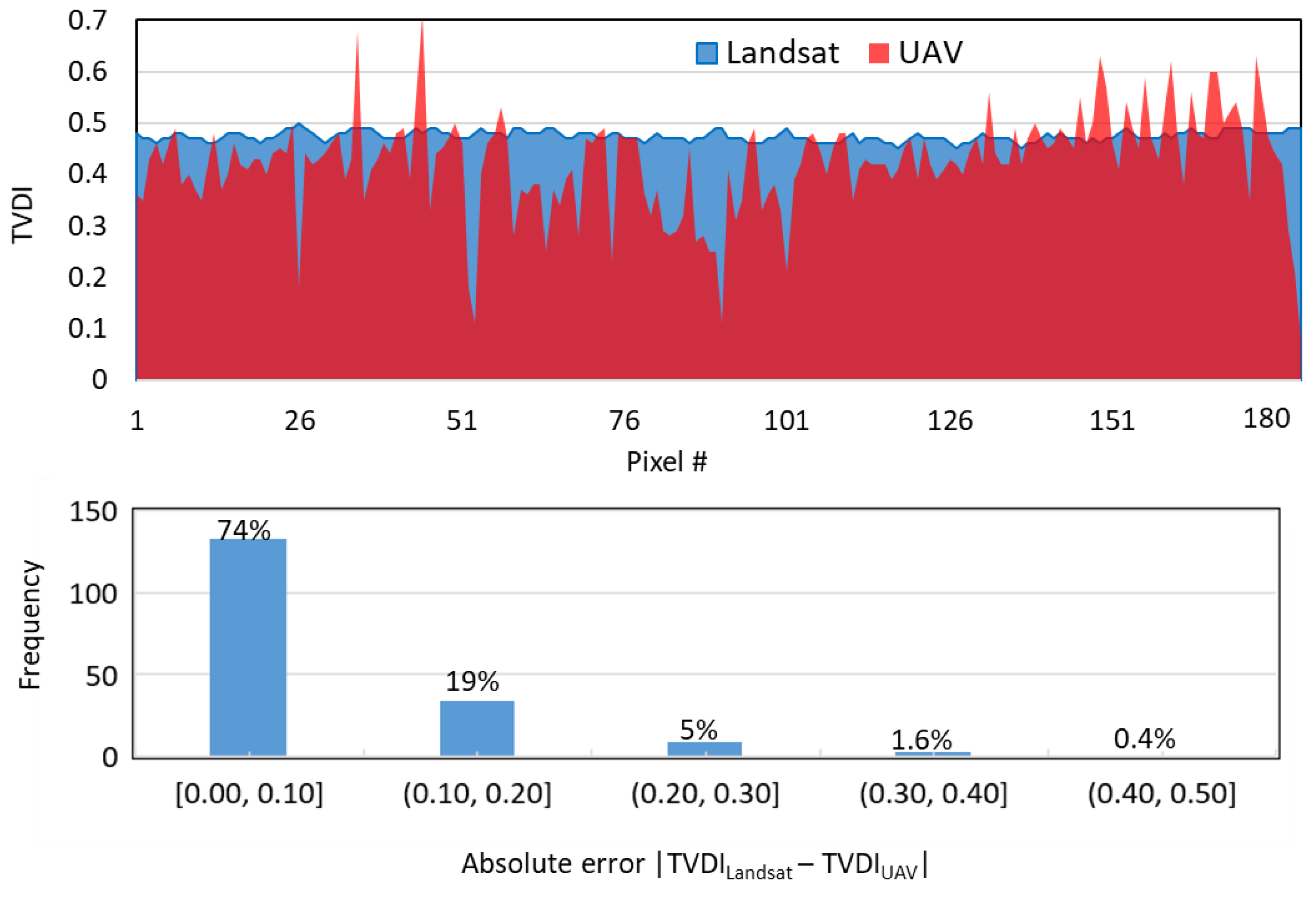




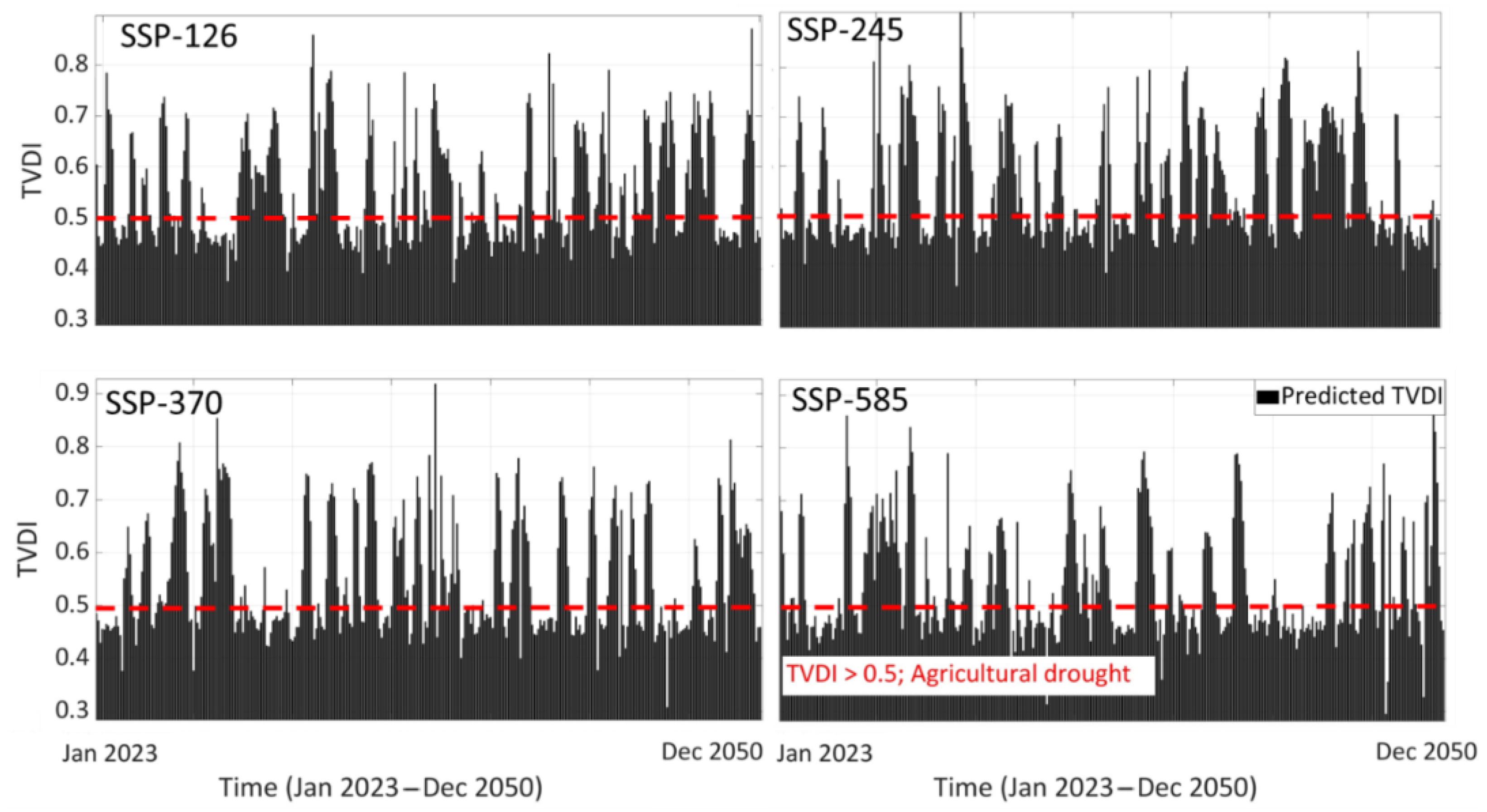
| No | Acronym | Name |
|---|---|---|
| 1 | UKESM1-0-LL | United Kingdom Earth System Model |
| 2 | TaiESM1 | Taiwan Earth System Model version 1 |
| 3 | NorESM2-MM | Norwegian Earth System Model-medium atmosphere-medium ocean resolution |
| 4 | NorESM2-LM | Norwegian Earth System Model-low atmosphere-medium ocean resolution |
| 5 | NESM3 | The NUIST Earth System Model version 3 |
| 6 | MRI-ESM2-0 | The Meteorological Research Institute Earth System Model Version 2.0 |
| 7 | MPI-ESM1-2-LR | Max Planck Institute Earth System Model-Lower-Resolved version |
| 8 | MPI-ESM1-2-HR | Max Planck Institute Earth System Model-Higher-Resolution version |
| 9 | MIROC6 | Model for Interdisciplinary Research on Climate |
| 10 | MIROC-ES2L | MIROC-Earth System version 2 for Long-term simulations |
| 11 | KIOST-ESM | Korea Institute of Ocean Science and Technology Earth System Model |
| 12 | KACE-1-0-G | Korea meteorological Administration advanced Community Earth-system model |
| 13 | IPSL-CM6A-LR | Institut Pierre Simon Laplace Climate Model |
| 14 | INM-CM5-0 | Institute for Numerical Mathematics-Climate Model version 5.0 |
| 15 | INM-CM4-8 | Institute for Numerical Mathematics-Climate Model version 4.8 |
| 16 | IITM-ESM | Indian Institute of Tropical Meteorology-Earth System Model |
| 17 | HadGEM3-GC31-MM | Hadley Centre Global Environment Model ver. 3-General Circulation Model 31-Model Mean |
| 18 | HadGEM3-GC31-LL | HadGEM3-GC31-Low Latitude |
| 19 | GISS-E2-1-G | NASA Goddard Institute for Space Studies-Earth sys. model ver. 2, config.1-Grand Ensemble |
| 20 | GFDL-ESM4 | Geophysical Fluid Dynamics Laboratory-Earth System Model version 4 |
| 21 | GFDL-CM4_gr2 | Geophysical Fluid Dynamics Laboratory-Climate Model version 4, grid resolution 2 |
| 22 | GFDL-CM4 | Geophysical Fluid Dynamics Laboratory-Climate Model version 4 |
| 23 | FGOALS-g3 | Institute of Atmospheric Physics Global Ocean-Atmosphere-Land System Model |
| 24 | EC-Earth3-Veg-LR | ECMWF Earth System Model with Vegetation |
| 25 | EC-Earth3 | ECMWF Earth System Model |
| 26 | CanESM5 | Canadian Earth System Model |
| 27 | CNRM-ESM2-1 | Centre National de Recherches Météorologiques Earth System Model |
| 28 | CNRM-CM6-1 | Centre National de Recherches Météorologiques Climate Model |
| 29 | CMCC-ESM2 | Euro-Mediterranean Centre on Climate Change-Earth System Model version 2 |
| 30 | CMCC-CM2-SR5 | CMCC-Climate Model version 2, Spectral Resolution 5 |
| 31 | CESM2-WACCM | Community Earth System Model with Whole Atmosphere Community Climate Model |
| 32 | CESM2 | Community Earth System Model version 2 |
| 33 | BCC-CSM2-MR | Beijing Climate Center Climate System Model |
| 34 | ACCESS-ESM1-5 | Australian Community Climate and Earth System Simulator |
| 35 | ACCESS-CM2 | Australian Community Climate and Earth System Simulator |
| Satellite | Date | Satellite | Date | Seattleite | Date | Seattleite | Date |
|---|---|---|---|---|---|---|---|
| L8 | 9 January 2020 | L8 | 23 October 2020 | L8 | 7 August 2021 | L9 | 5 December 2021 |
| L8 | 25 January 2020 | L8 | 24 November 2020 | L8 | 26 October 2021 | L9 | 21 December 2021 |
| L8 | 10 February 2020 | L8 | 10 December 2020 | L8 | 11 November 2021 | L9 | 6 January 2022 |
| L8 | 26 February 2020 | L8 | 26 December 2020 | L8 | 27 November 2021 | L9 | 22 January 2022 |
| L8 | 13 March 2020 | L8 | 11 January 2021 | L8 | 13 December 2021 | L9 | 7 February 2022 |
| L8 | 29 March 2020 | L8 | 27 January 2021 | L8 | 29 December 2021 | L9 | 23 February 2022 |
| L8 | 14 April 2020 | L8 | 12 February 2021 | L8 | 14 January 2022 | L9 | 11 March 2022 |
| L8 | 30 April 2020 | L8 | 28 February 2021 | L8 | 30 January 2022 | L9 | 27 March 2022 |
| L8 | 16 May 2020 | L8 | 16 March 2021 | L8 | 15 February 2022 | L9 | 18 August 2022 |
| L8 | 1 June 2020 | L8 | 1 April 2021 | L8 | 3 March 2022 | L9 | 5 October 2022 |
| L8 | 17 June 2020 | L8 | 17 April 2021 | L8 | 19 March 2022 | L9 | 21 October 2022 |
| L8 | 4 August 2020 | L8 | 3 May 2021 | L8 | 4 April 2022 | L9 | 6 November 2022 |
| L8 | 20 August 2020 | L8 | 19 May 2021 | L8 | 29 October 2022 | L9 | 22 November 2022 |
| Satellite | Parameter i | K1 | K2 |
|---|---|---|---|
| L8 | Band 10 | 774.8853 | 1321.0789 |
| L8 | Band 11 | 480.8883 | 1201.1442 |
| L9 | Band 10 | 799.0284 | 1329.2405 |
| L9 | Band 11 | 475.6581 | 1198.3494 |
| ) | Equation [44] |
|---|---|
| 0.2–3.0 | |
| 3.0–6.0 | |
| SPI | Class | SPI | Class |
|---|---|---|---|
| 2 or more | Extreme wet | −1 to −1.49 | Moderate drought |
| 1.5 to 1.99 | Very wet | −1.5 to −1.99 | Severe drought |
| 1 to 1.49 | Moderate wet | −2 or less | Extreme drought |
| −0.99 to 0.99 | Near normal |
Disclaimer/Publisher’s Note: The statements, opinions and data contained in all publications are solely those of the individual author(s) and contributor(s) and not of MDPI and/or the editor(s). MDPI and/or the editor(s) disclaim responsibility for any injury to people or property resulting from any ideas, methods, instructions or products referred to in the content. |
© 2024 by the authors. Licensee MDPI, Basel, Switzerland. This article is an open access article distributed under the terms and conditions of the Creative Commons Attribution (CC BY) license (https://creativecommons.org/licenses/by/4.0/).
Share and Cite
Hobart, M.; Schirrmann, M.; Abubakari, A.-H.; Badu-Marfo, G.; Kraatz, S.; Zare, M. Drought Monitoring and Prediction in Agriculture: Employing Earth Observation Data, Climate Scenarios and Data Driven Methods; a Case Study: Mango Orchard in Tamale, Ghana. Remote Sens. 2024, 16, 1942. https://doi.org/10.3390/rs16111942
Hobart M, Schirrmann M, Abubakari A-H, Badu-Marfo G, Kraatz S, Zare M. Drought Monitoring and Prediction in Agriculture: Employing Earth Observation Data, Climate Scenarios and Data Driven Methods; a Case Study: Mango Orchard in Tamale, Ghana. Remote Sensing. 2024; 16(11):1942. https://doi.org/10.3390/rs16111942
Chicago/Turabian StyleHobart, Marius, Michael Schirrmann, Abdul-Halim Abubakari, Godwin Badu-Marfo, Simone Kraatz, and Mohammad Zare. 2024. "Drought Monitoring and Prediction in Agriculture: Employing Earth Observation Data, Climate Scenarios and Data Driven Methods; a Case Study: Mango Orchard in Tamale, Ghana" Remote Sensing 16, no. 11: 1942. https://doi.org/10.3390/rs16111942








